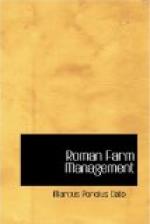c. Cuttage
In respect of cuttage, which consists in planting in the ground a live cutting from a tree, it behooves you especially to see that this is done at the proper time, which is before the tree has begun to bud or bloom: that you take off the cutting carefully rather than break it from the parent tree, because the cutting will be more firmly established in proportion as it has a broad footing which can readily put out roots: and that it is planted promptly before the sap dries out of it.
In propagating olives select a truncheon of new grown wood about a foot in length and the same size at each end: some call these clavolae and others call them taleae.
d. Graftage
In respect of graftage, which consists in transferring growing wood from one tree to another, care must be taken in selecting the tree from which the scion is taken, the tree on which it is grafted, and the time and the manner in which it is done: for the pear cannot be grafted on an oak, even though it may upon the apple. In this operation many men who have great faith in the sayings of the soothsayers give heed to their warning that as many kinds of grafts there may be on a tree so many bolts of lightning will strike it, because a bolt of lightning is generated by each graft (ictu).[91]
If you graft a cultivated pear upon a wild pear tree no matter how good it may be, the result will not be as fortunate as if you had grafted on another cultivated pear. Having regard for the result, on what ever kind of tree you graft, if it is of exactly the same kind, as, for instance, apple on apple, you should take care that the scion comes from a better tree than that on which it is grafted.
e. A “new” method—inarching
There is another operation recently suggested,[92] for propagating one tree from another, when the trees are neighbours. From the tree from which you wish to take a scion a branch is trained to that on which you wish to make the graft and the scion is bound upon an incision in a branch of the stock. The place of contact of both scion and stock is cut away with a knife so that the bark of one joins evenly with the bark of the other at the point of exposure to the weather. Care should be taken that the growing top of the scion is pointed straight upwards. The following year when the graft has knitted, the scion may be cut from its parent tree.
Of when to use these different methods
XLI. The most important consideration in propagating is, however, the time at which you do it: thus things which formerly were propagated in the spring now are propagated in summer, like the fig, whose wood is not heavy and so craves heat, as a consequence of which quality figs cannot be grown in cold climates. For the same reason water is dangerous to a new fig graft because its soft wood rots easily. For these reasons it is now considered that midsummer is




